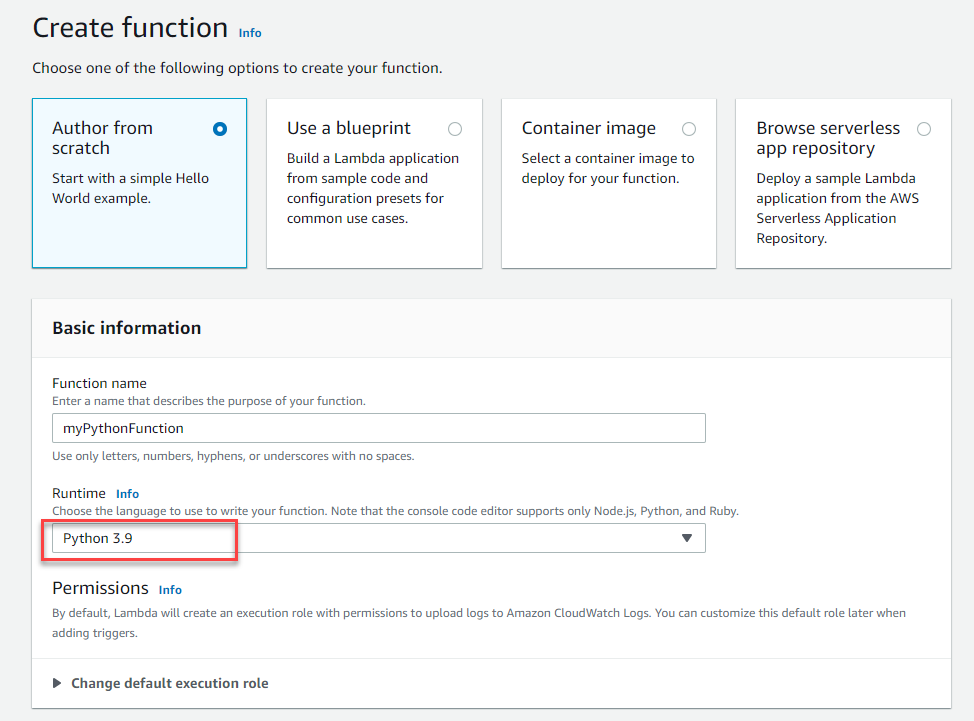AWS Compute Blog
Python 3.9 runtime now available in AWS Lambda
You can now use the Python 3.9 runtime to develop your AWS Lambda functions. You can do this in the AWS Management Console, AWS CLI, or AWS SDK, AWS Serverless Application Model (AWS SAM), or AWS Cloud Development Kit (AWS CDK). This post outlines some of the improvements to the Python runtime in version 3.9 and how to use this version in your Lambda functions.
New features and improvements to the Python language
Python 3.9 introduces new features for strings and dictionaries. There are new methods to remove prefixes and suffixes in strings. To remove a prefix, use str.removeprefix(prefix). To remove a suffix, use str.removesuffix(suffix). To learn more, read about PEP 616.
Dictionaries now offer two new operators (| and |=). The first is a union operator for merging dictionaries and the second allows developers to update the contents of a dictionary with another dictionary. To learn more, read about PEP 584.
You can alter the behavior of Python functions by using decorators. Previously, these could only consist of the @ symbol, a name, a dotted name, and an optional single call. Decorators can now consist of any valid expression, as explained in PEP 614.
There are also improvements for time zone handling. The zoneinfo module now supports the IANA time zone database. This can help remove boilerplate and brings improvements for code handling multiple timezones.
While existing Python 3 versions support TLS1.2, Python 3.9 now provides support for TLS1.3. This helps improve the performance of encrypted connections with features such as False Start and Zero Round Trip Time (0-RTT).
For a complete list of updates in Python 3.9, read the launch documentation on the Python website.
Performance improvements in Python 3.9
There are two important performance improvements in Python 3.9 that you can benefit from without making any code changes.
The first impacts code that uses the built-in Python data structures tuple, list, dict, set, or frozenset. In Python 3.9, these internally use the vectorcall protocol, which can make function calls faster by reducing the number of temporary objects used. Second, Python 3.9 uses a new parser that is more performant than previous versions. To learn more, read about PEP 617.
Changes to how Lambda works with the Python runtime
In Python, the presence of an __init__.py file in a directory causes it to be treated as a package. Frequently, __init__.py is an empty file that’s used to ensure that Python identifies the directory as a package. However, it can also contain initialization code for the package. Before Python 3.9, where you provided your Lambda function in a package, Lambda did not run the __init__.py code in the handler’s directory and parent directories during function initialization. From Python 3.9, Lambda now runs this code during the initialization phase. This ensures that imported packages are properly initialized if they make use of __init__.py. Note that __init__.py code is only run when the execution environment is first initialized.
Finally, there is a change to the error response in this new version. When previous Python versions threw errors, the formatting appeared as:
{"errorMessage": "name 'x' is not defined", "errorType": "NameError", "stackTrace": [" File \"/var/task/error_function.py\", line 2, in lambda_handler\n return x + 10\n"]}
From Python 3.9, the error response includes a RequestId:
{"errorMessage": "name 'x' is not defined", "errorType": "NameError", **"requestId"**: "<request id of function invoke>" "stackTrace": [" File \"/var/task/error_function.py\", line 2, in lambda_handler\n return x + 10\n"]}
Using Python 3.9 in Lambda
You can now use the Python 3.9 runtime to develop your AWS Lambda functions. To use this version, specify a runtime parameter value python3.9 when creating or updating Lambda functions. You can see the new version in the Runtime dropdown in the Create function page.
To update an existing Lambda function to Python 3.9, navigate to the function in the Lambda console, then choose Edit in the Runtime settings panel. You see the new version in the Runtime dropdown:
In the AWS Serverless Application Model (AWS SAM), set the Runtime attribute to python3.9 to use this version in your application deployments:
AWSTemplateFormatVersion: '2010-09-09'
Transform: AWS::Serverless-2016-10-31
Description: Simple Lambda Function
Resources:
MyFunction:
Type: AWS::Serverless::Function
Description: My Python Lambda Function
Properties:
CodeUri: my_function/
Handler: lambda_function.lambda_handler
Runtime: python3.9
Conclusion
You can now create new functions or upgrade existing Python functions to Python 3.9. Lambda’s support of the Python 3.9 runtime enables you to take advantage of improved performance and new features in this version. Additionally, the Lambda service now runs the __init_.py code before the handler, supports TLS 1.3, and provides enhanced logging for errors.
For more serverless learning resources, visit Serverless Land.

